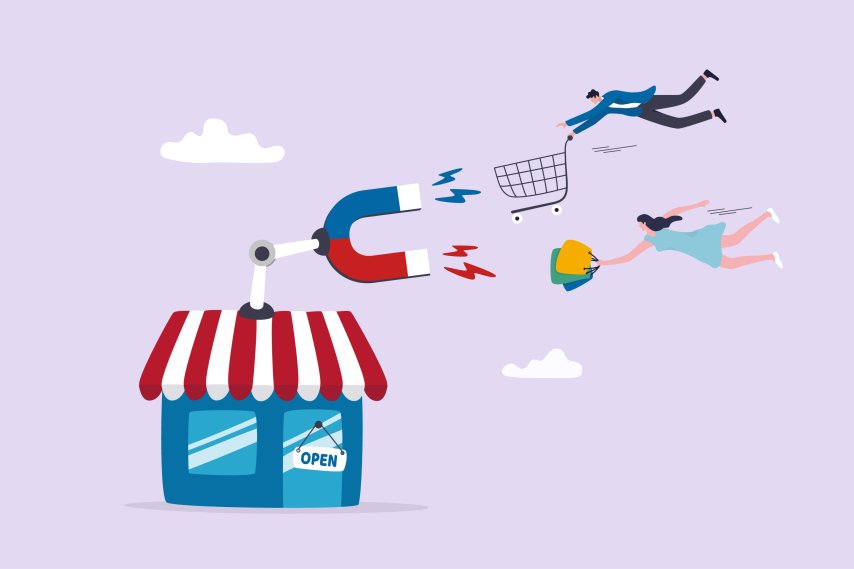Effective Shopify marketing: strategies for more sales in your online store

Would you like to make your Shopify store better known and increase your sales? Find out in this article how you can reach your target audience and boost your sales with effective Shopify marketing. From SEO optimization to email marketing, we offer you ideas, strategies and tools that can be implemented directly with a focus on practical solutions.
The most important things at a glance
- The basis for successful Shopify marketing lies in defining clear goals, analyzing the target group and identifying unique selling propositions (USPs) - this is how the 4Ps (Product, Price, Place, Promotion) can be applied to Shopify marketing.
- Effective Shopify marketing strategies include search engine optimization (SEO), the use of social media, but influencer marketing is also a possibility, as well as the implementation of targeted email marketing campaigns for improved customer loyalty and increased sales.
- It is essential to regularly measure and analyze the performance of marketing measures (e.g. open and click rates), take legal aspects into account and conduct multi-channel marketing to promote customer lifetime value and ensure long-term success.
Shopify marketing basics
Identifying your Unique Selling Propositions (USPs) is crucial to stand out from the competition. By highlighting unique product features, customer benefits or special services, you can win over potential customers and build long-term customer relationships. It's about clearly communicating what makes your offer special and anchoring it in the memory of your target group. The 4Ps of marketing - product, price, place, promotion - are crucial tools in the marketing mix.
Corporate identity influences the perception of your company both internally and externally and should be incorporated into all marketing measures. A strong corporate identity not only creates instant recognition value, but also serves as the basis for developing a consistent brand message across all communication channels. It reflects the values and philosophy of your company and helps to establish an emotional connection with your target group. A well-thought-out corporate identity makes all marketing activities more effective as they build on a consistent and strong brand presence. It also supports the trust and credibility that customers place in your brand and can therefore contribute significantly to customer loyalty and differentiation from the competition. This first step will help you build a strong connection with your target audience and increase your sales while continuously monitoring and optimizing your marketing efforts.
Strategies to increase the visibility of your Shopify store
Now that we've established the basics of Shopify marketing, let's focus on how to increase your Shopify store's visibility. Choosing the right keywords can help you achieve better search engine rankings, which is necessary to be found by potential customers. Regularly analyzing and adjusting your SEO strategy is important to respond to changes in search engine algorithms and the market. Shopify offers various SEO-friendly features that can improve the ranking of your online store in search engines.
SEO optimization for your Shopify store
SEO is an effective, long-term strategy that has the potential to reduce customer acquisition costs and increase sales. On-page optimization includes creating relevant content based on keywords, improving image search through alt texts and reviewing technical SEO. In addition, a comprehensive on-page SEO strategy also includes optimizing meta tags, structuring URLs and ensuring a fast website load time, which improves the user experience and can contribute to a higher conversion rate. Implementing structured data to generate rich snippets in the search results can further increase the click-through rate and significantly improve the visibility of your store in the search engines. Off-page optimization, which focuses on measures outside of your own website, such as link building and social media signals, is also a crucial factor for a strong ranking. A successful SEO strategy requires continuous adaptation and updating to keep up with the ever-changing search engine algorithms and maintain competitiveness.
In addition, regularly publishing relevant blog content can expand keyword reach and provide search engines with fresh content that can help improve rankings. This is particularly important as high-quality content is favored by Google and other search engines and can therefore increase the visibility of your store in search results. By including relevant keywords in your blog articles, you can not only improve your SEO position, but also offer your readers added value through informative and interesting content. This can increase the time spent on your website and improve the likelihood of conversions. Off-page SEO tactics focus on building backlinks from other high-quality websites to increase authority and credibility. Through targeted collaborations and placing guest posts on industry-relevant sites, you can not only gain valuable backlinks, but also expand your reach and tap into new audiences.
Social media as an amplifier for your brand
In addition to SEO, social media platforms are also an effective tool for increasing brand awareness and establishing an engaged community. Through target group-specific content, influencer marketing and interactive content, Shopify stores can successfully promote their products and attract more visitors to their websites. Customer loyalty can be strengthened through regular interaction and the sharing of user-generated content, which also promotes brand awareness. Social media platforms make it possible to reach a wide range of customers through targeted advertising campaigns and organic posts. Using hashtags, placing targeted ads and interacting with followers through comments and direct messages are just some of the ways to increase presence on these platforms. By analyzing engagement and performance data, Shopify stores can continuously adapt and optimize their social media strategy to achieve the greatest possible effect.
Using email marketing campaigns effectively
Regular newsletters and surveys make it possible to continuously stay in touch with subscribers and use customer feedback to improve products and services. This form of direct communication is key to building a strong customer relationship and promoting customer loyalty.
Optimize newsletter registration
Before we get into the details of newsletter design, however, it's important to look at the sign-up process itself. An optimized sign-up process is crucial to laying the foundation for successful email marketing campaigns. The registration form should be easily accessible and prominently placed, for example in the footer or sidebar. A one-field registration form and a simple registration procedure within two clicks increase the likelihood of registrations. Pop-ups can draw attention to the newsletter registration, but should be designed in such a way that they are not perceived as annoying.
The visual design of the registration form can arouse interest with attractive colors and designs and highlight the submit button. Communicating clear benefits such as exclusive information, early access to sales or discounts motivates people to sign up for the newsletter. Social proof, such as testimonials from subscribers and graphic images of the newsletter, increase credibility and interest.
Designing convincing marketing emails
In addition to optimizing the registration process, it is equally important to design appealing and convincing marketing emails. The creativity and uniqueness of the subject line and preheader are crucial for emails to be opened in the first place. By embedding videos, adding interactive elements such as quizzes and using dynamic content, the email is perceived as more personal and engaging, which can increase engagement rates.
A professional, brand-compliant design should have the following features:
- A structured layout
- Attractive header images
- Clear design elements
- Eye-catching call-to-actions
These elements achieve a high level of recognition.
Create personalized customer experiences
In today's digital world, customers want more than just products; they want personalized experiences. A well-designed email marketing campaign can help send personalized emails that have higher open rates than general mass emails, which can lead to increased customer loyalty and sales.
Personalized content and offers make customers feel individually valued and understood, which increases customer satisfaction and therefore customer loyalty.
Segmentation of customer lists
Segmenting customer lists is an effective way to create personalized content and offers. Segmentation allows specific target groups to be addressed with relevant content, increasing the likelihood of engagement and conversions. Segmenting the recipient list according to various criteria enables a targeted approach and improves the relevance of the content. By segmenting recipients into different groups, more targeted approaches can be made, which can lead to higher open and click rates.
The segmentation of email lists is based on the grouping of contacts according to characteristics or behavior, which enables granular targeting of marketing campaigns. The filters for segmentation can be based on the following criteria:
- socio-demographic characteristics
- purchase history
- interests
- the degree of interaction with previous messages
When creating segments, filters or conditions are set that are applied to contact lists to define the desired target group.
Use automations
Automations are another key to creating personalized customer experiences. Email automations such as cart abandonment emails or birthday messages can boost sales and increase customer loyalty. Predefined rules can be used to send personalized and timely messages to customers automatically based on specific customer actions.
Design tips for eye-catching email campaigns
The design of your email campaigns plays an essential role in achieving your marketing goals. To achieve this, you should create an effective "campaign" and keep the following points in mind:
- Use Responsive Design to automatically adjust the display of your emails to the screen width of mobile devices.
- Adjust the font size to improve readability on mobile devices. Use at least 22px for headlines and 12px for body text.
- Place an eye-catching call-to-action in the visible area of the email to ensure that it can be seen directly without scrolling.
By implementing these tips, you can ensure that your email campaigns are effective and achieve your marketing goals.
The use of images can enrich the email design, but should be balanced between text and image and placed in a visually appealing way. It should be noted that people pictured in the newsletter should look in the direction of the call to actions to draw attention to them. Bullet points and short paragraphs are suitable for promoting a better structure and readability of the newsletter.
Measuring and analyzing the success of your email marketing campaigns
Measuring and analyzing the success of your email marketing campaigns is essential for their continuous improvement. Key performance indicators for evaluating the effectiveness of email marketing campaigns are
- Open rate
- click rate
- conversion rate
- unsubscribe rate
- Bounce rate.
A high conversion rate shows that a significant proportion of recipients have carried out the desired action, which is a direct indicator of the campaign's success.
Analyze open and click rates
Analyzing the open and click rates of your email campaigns is an important step in evaluating their success. The open rate indicates how many of the emails sent were opened by the recipients and is an indicator of a successful subject line and interesting content. The click-through rate shows how many recipients clicked on a link after opening the email and indicates relevant, appealing content.
A high unsubscribe rate can indicate that the campaign was ineffective or irrelevant, while a low unsubscribe rate indicates a high acceptance of the content.
Use A/B tests for optimization
A/B testing is a useful tool for optimizing your email campaigns. A/B tests involve comparing two versions of a newsletter to find out which version is better received by recipients.
A/B tests can be used to test and optimize not only the subject lines, but also call-to-action elements in order to increase the click-through rate.
Consider legal aspects in email marketing
There are a number of legal aspects to consider in the area of email marketing. The double opt-in procedure requires additional confirmation of the email address by clicking on a link in a confirmation email and offers greater legal security. In court proceedings, the double opt-in is often preferred in order to clarify consent in the event of disputes; in addition, confirmation by the user is required for newsletter registration under the Competition Act.
Email addresses are personal data and must be treated in accordance with data protection regulations such as the General Data Protection Regulation. The GDPR regards direct advertising as a legitimate interest of the controller, which may allow the sending of email advertising without consent under certain conditions. Securing personal data and complying with data protection regulations are essential to ensure trust and legal security in email marketing.
Multi-channel marketing: combining different marketing channels
In today's digital world, it is important not to rely on just one channel, but to pursue a multi-channel marketing strategy. This strategy combines different marketing channels such as email, social media, SEO, content marketing and advertisements to reach a broader audience and create different touchpoints with potential customers.
By integrating multiple channels into your marketing campaigns, you can ensure that your message is communicated in a variety of ways, increasing the likelihood of it being noticed by your target audience. It also allows you to leverage the strengths of each channel to create a synergistic effect that can boost the overall performance of your marketing efforts.
However, it is important to maintain a coherent and consistent brand message across all channels to avoid confusion and build customer trust. Analyzing the data from the different channels will also help you to better understand the behavior and preferences of your target audience and adjust your strategy accordingly.
Summary and conclusion
The practical tips and examples provided in this guide should help you optimize your marketing efforts and make your Shopify store a success. By applying the methods discussed here, you can build a strong brand presence, create a loyal customer base and ultimately increase your sales. If you still need help with your Shopify online store or your Shopify marketing, you can contact us at any time. We support you as a full-service e-commerce agency.
Was ist dein Projekt? Wenn du uns darüber erzählen möchtest, rufen wir dich zurück!

Hello, my name is Meike. I take care of the EXWE back office and am responsible for our social media channels. All of our articles are meant to make your life easier and help you make decisions. Nevertheless, it can happen that something remains unclear, so: If you have questions about this article you can easily reach me at +49 231 93149827.
We make the big Shopware and Salesforce comparison so that you can find out which store system is best suited to your company.
What is a headless content management system? Here you will find all the information, advantages and challenges as well as an introduction to various systems!
The big comparison: Shopify vs. Shopify Plus Meta Description: Shopify vs. Shopify Plus - the comparison ✓ All functions ✓ Advantages and disadvantages ➔ Learn more & find the right version for your company





